
In the previous article, I brought you "The exciting basics of regular expressions in PHP (detailed illustrations)", which mainly talked about the basic knowledge of PHP regular expressions and how to use them through examples. Learn how to use it. This article continues to learn about the PHP file system. I hope to be helpful!

When we use the computer, we all use the computer to open and close a file, create a file or upload a file. So can these operations be done in code? If it can be done, how should it be done? In fact, it is very simple. Learning file processing is actually learning the functions of file processing and combining it with what you have learned before. So let’s take a look next.
Reading files can be regarded as one of the most common operations in our daily use, so how to implement it in the code.
The following will introduce how to use functions in PHP to read file contents.
fgetc(): Read a character from a file
Before using these functions to read a file, We need to first create a text file in the server root directory (here we take text.txt as an example). The text content is as follows:
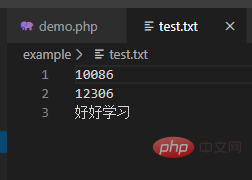
Let’s take a look. How should fgetc() be used and what is the output result:
<?php
header("Content-Type: text/html;charset=utf-8");
$handle = fopen('test.txt', 'r');
$a = fgetc($handle) ;
echo $a;
?>Output result:

fgetc can only read Taking a character, we can use the loop mentioned before to combine it, and we can get the following example:
<?php
header("Content-Type: text/html;charset=utf-8"); //设置字符编码
$handle = fopen('test.txt', 'r'); //打开文件
if (!$handle) { //判断文件是否打开成功
echo '文件打开失败!';
}
while (false !== ($char = fgetc($handle))) { //循环读取文件内容
echo $char;
}
fclose($handle); //关闭文件
?>Output result:

fgets() and fgetss(): Read the file line by line
<?php
header("Content-Type: text/html;charset=utf-8");
$handle = fopen('test.txt', 'r');
$a = fgets($handle) ;
echo $a;
?>Output result:

The fgetss() function is a variant of fgets() and is also used to read a row of data. It will also filter while reading. Remove the PHP and HTML tags in the read content.
It can be seen that the file can be read line by line through fgets. At the same time, as above, we can use a loop to read all files.
The example is as follows:
<?php
$handle = @fopen("test.txt", "r");
if ($handle) {
while (($info = fgets($handle, 1024)) !== false) {
echo $info.'<br>';
}
fclose($handle);
}
?>Output result:

##fread(): Read the file (any length)
##
<?php
$filename = "test.txt";
$handle = fopen($filename, "r");
$contents = fread($handle, '6');
echo '从文件中读取 6 个字符长度:'.$contents.'<br>';
rewind($handle);
$contents = fread($handle, filesize($filename));
echo '读取全部的文件内容:'.$contents;
fclose($handle);
?>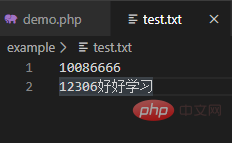 Output result:
Output result: 
readfile(): Read all files <?php
$file = 'test.txt';
$info = readfile($file);
?>

file(): Read the entire file into an array <?php
$file = 'test.txt';
$arr = file($file, FILE_IGNORE_NEW_LINES);
$arr2 = file($file);
echo '<pre class="brush:php;toolbar:false">';
var_dump($arr);
var_dump($arr2);
?>
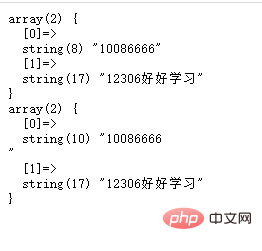
##file_get_contents(): Read the file into a string First, we First create a test.txt file
and then enter: 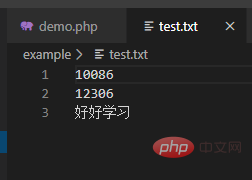
<?php
$a = 'test.txt';
$b = file_get_contents($a);
//因为每一行有一个回车即\n,我用\n来把这个字符串切割成数组
$c = explode("\n", $b);
//把切割成的数组,下标赋值给$key,值赋值给$val,每次循环将$key加1。
while (list($key, $val) = each($c)) {
++$key;
$val = trim($val);
//用的单引号,单引号不解释变量进行了拼接而已
print 'Line' . $key .':'. $val.'<br />';
}
?>This is the integration of the knowledge we learned. First, we opened the file through file_get_contents, and then obtained the output results through the list each statement and while loop. 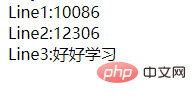
The above file_get_contents method of opening a file is simple and crude, then the next Several
resource fopen ( string $文件名, string 模式) string fread ( resource $操作资源, int 读取长度) bool fclose ( resource $操作资源 )
fopen function The function of the fopen function is to open a file. There are two main parameters:
The path to open the file
Open file mode
The return type is a resource type, and the resource type requires other functions to operate this resource. All resources must be closed when they are opened.
fread function: The function of the function is to read the open file resource. Read the file resource of the specified length, read part of it and move part backward. to the end of the file.
fclose function: The function of fclose function is to close resources. Resources are opened and closed.
Next, I will introduce to you the mode of the fopen function:
r Open in read-only mode and point the file pointer to the file header.
r Open in read-write mode and point the file pointer to the file header.
w Open the writing mode, point the file pointer to the file header and cut the file size to zero. If the file does not exist, try to create it
w Open in read-write mode, point the file pointer to the file header and truncate the file size to zero. If the file does not exist, try to create it.
#a Open in writing mode and point the file pointer to the end of the file. If the file does not exist, try to create it
a Open it in read-write mode and point the file pointer to the end of the file. If the file does not exist, try to create it
x Create and open it for writing, pointing the file pointer to the file header. If the file already exists, the fopen() call fails and returns FALSE and generates an E_WARNING level error message. If the file does not exist, try to create it
x Create and open it in read-write mode, pointing the file pointer to the file header. If the file already exists, the fopen() call fails and returns FALSE and generates an E_WARNING level error message. If the file does not exist, try to create it
Recommended learning: "PHP Video Tutorial"
The above is the detailed content of How to read files in PHP? (Share summary). For more information, please follow other related articles on the PHP Chinese website!